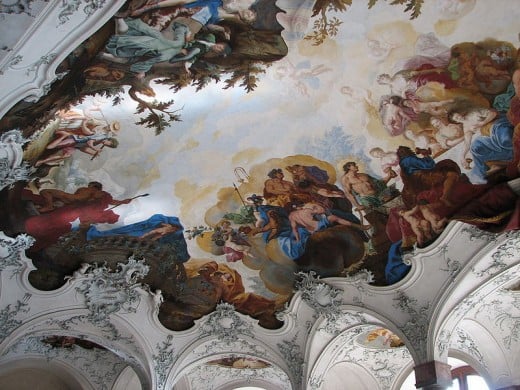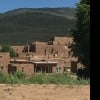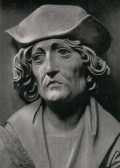Tiepolo and the Wurzburger Residenz
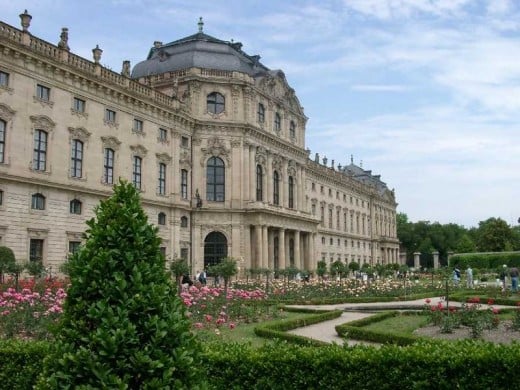
Wurzburger Residenz
The Wurzburger Residenz or Wurzburg Residence is the Prince-bishop palace located in downtown Wurzburg, Germany in the state of northern Bavaria. From the middle ages forward, Wurzburg was ruled by a Prince-bishop and this particular palace in Germany is one of the most spectacular for two reasons: the Baroque architecture style and the painted frescos inside. The splendor of the architecture fused with the airy and light frescos brings about the fusion of reality and illusion all at the same time.
The Residenz was commissioned by the Prince-bishop of Wurzburg at the time (1720), Johann Philipp Franz von Schonborn and his brother Friedrich Carl von Schonborn. It was completed in 1744. The principal architect was Balthasar Neumann, who was the architect for the court of the Bishop of Wurzburg. He was assisted by several other architects, Johann Lukas von Hildebrandt and Maximillan von Welsch who brought with them the Austrian and Southern Germany Baroque style. Robert de Cotte and Germain Boffrand were brought in as they were followers of the French style.
Prince-bishop Johann Philipp Franz von Schonborn (1719-1724) moved the court from the Marienberg Fortress on the hill to the newly erected palace, The Residenz, and the prince-bishops of Wurzburg resided there from then on throughout history,
The great interiors of the Residenz include the Treppenhaus (the grand staircase), the Hofkirche (the chapel) and the Kaisersaal (the grand salon). Decorating the ceilings and walls are the frescos of the great Venetian artist, Giovanni Battista Tiepolo, assisted by his sons, Domenico and Lorenzo.
Scholars and art historians have called Tiepolo "the greatest decorative painter of the 18th century Europe, as well as its most able craftsman." Frescos by Tiepolo and his sons decorated the grand salon (1752-52) and the ceiling above the grand staircase (1752-1753).

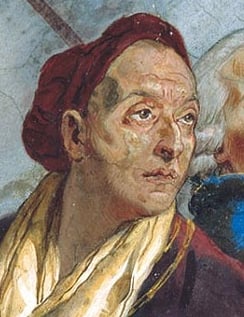
Giovanni Battista Tiepolo (1696-1770)
Heralded as the last great Venetian painter from Italy, Tiepolo was an Italian painter and printmaker. His works became famous all over Europe and his reputation was greatly established and, therefore, he worked extensively in Italy, Germany and Spain during his lifetime. He was commissioned by the Prince-bishop of Wurzburg at the time, Karl Philipp von Greiffenklau, to decorate the inside of the Residenz. He traveled to Wurzburg in 1750 and stayed three years to paint the frescos on the ceilings and walls in the Residenz. He frescoed the ceiling above the Treppenhaus (the grand staircase) and the ceiling in the Kaisersaal (the grand salon) in collaboration with his sons.
Tiepolo also designed and painted the grandiose entrance staircase of the Residenz. The massive ceiling fresco over the staircase was 7,287 sq ft. and completed in November 1753. It is called "The Allegory of the Planets and Continents" and depicts Apollo embarking on his daily course. Deities surround him and symbolize the planets and the allegorical figures respresent the four continents.
He included several portraits in the Europe section of this fresco, including a self-portrait; a portrait of one of his sons, Domenico; a portrait of the Prince-bishop von Greiffenklau; and one of the architect, Balthasar Neumann. He also included a portrait of the painter Antonio Bosse.
Tiepolo returned to Venice, Italy in 1753 when he completed his frescos in the Residenz.
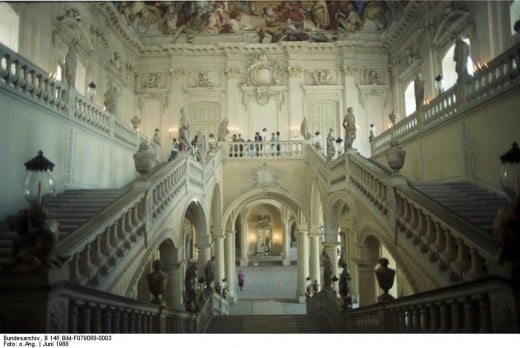
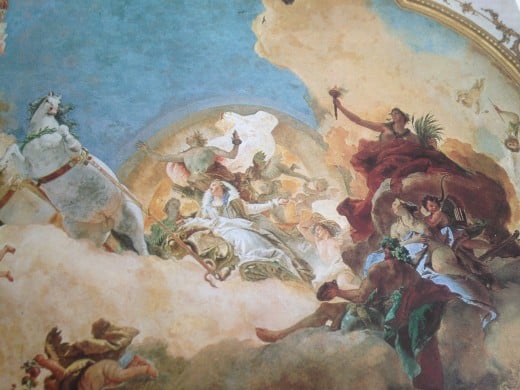
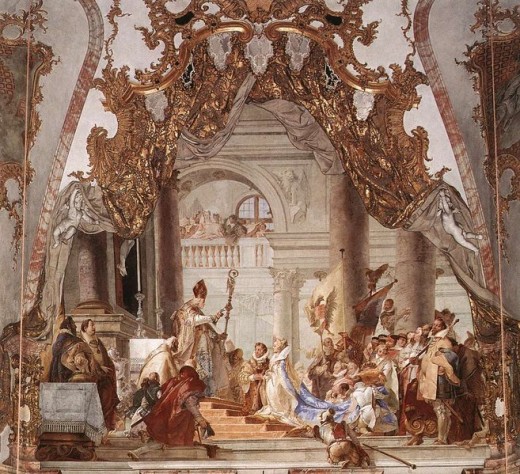
Tiepolo, his frescos, and The Residenz
Art historians have deemed Tiepolo's frescos and paintings in the Wurburger Residenz one of the superior achievements of 18th century art. The first of his frescos was painted above the Kaisersaal (the grand salon) and is the blending of the elements of marble, gold, stucco and glass that come together with color, light and the fluency of Tiepolo's paintings to create Gesamtkunstwerk, which in German means the union of the total arts. This room is one of Neumann's and Tiepolo's greatest achievements. The ceiling of the Kaisersaal depicts incidents from the life of Emperor Friederick Barbossa, who had invested the Bishop of Wurzburg in 1168.
Tiepolo's interpretation of the event transports the action into the 16th century and into the Venetian costume of the Veronese. It is incandescent with the light. It shows Apollo bringing the bride, Beatrice across the heavens in a triumphal chariot to her husband-to-be, Friedrick. This is the grand fresco created and a magnificent painting for the grand salon.
On the ceiling above the Treppenhaus (grand stairway), Tiepolo painted Olympus with the four quarters or continents of the Earth and painted it quite luminous.
In the 1750's, Tiepolo's art was at his most mature and was the embodiment of Baroque fresco, quite inventive yet controlled and disposed with crystal clarity. His paintings on the ceilings and walls of The Residenz fused illusion with reality as the architectural structure automatically lifts the eyes to his frescos. The airy lightness of the fescos illuminates the entire room and the staircase.
Tiepolo's genius is brought out in these frescos because it is a type of painting that requires fast working over great vast areas of The Residenz. The painting must be done quickly before the plaster dries. His frescos are characteristic of a high tonal key within which he could even make his shadows glow with light.
Tiepolo's frescos in The Residenz are joyful and radiant. The overwhelming impact of his art is its heart and soul lifting color and light.
Neumann's architecture and Tiepolo's frescos brought together make this palace one of the most beautiful in Germany and all of Europe for that matter. The frescos and architecture here even outshines Neuschwanstein in southern Bavaria.
Today, you can tour The Residenz both inside, to view the magnificent architecture and frescos and, of course, outside to tour the beautiful gardens. Each June, The Residenz is the host to the month long Wurzburg Mozart Fest. Concerts are given both outside in the gardens and inside the grand salon. Here visitors' senses are aroused by the combination of the magnificence of Mozart's music, the Baroque designs of Neumann's architecture and the beauty and light of Tiepolo's frescos. It is an experience to behold.
Source: Piper, David. The Illustrated History of Art. Octopus Publishing Group Lmt., London, England (1981). 2004 Edition.
Copyright (c) 2013 Suzannah Wolf Walker all rights reserved
